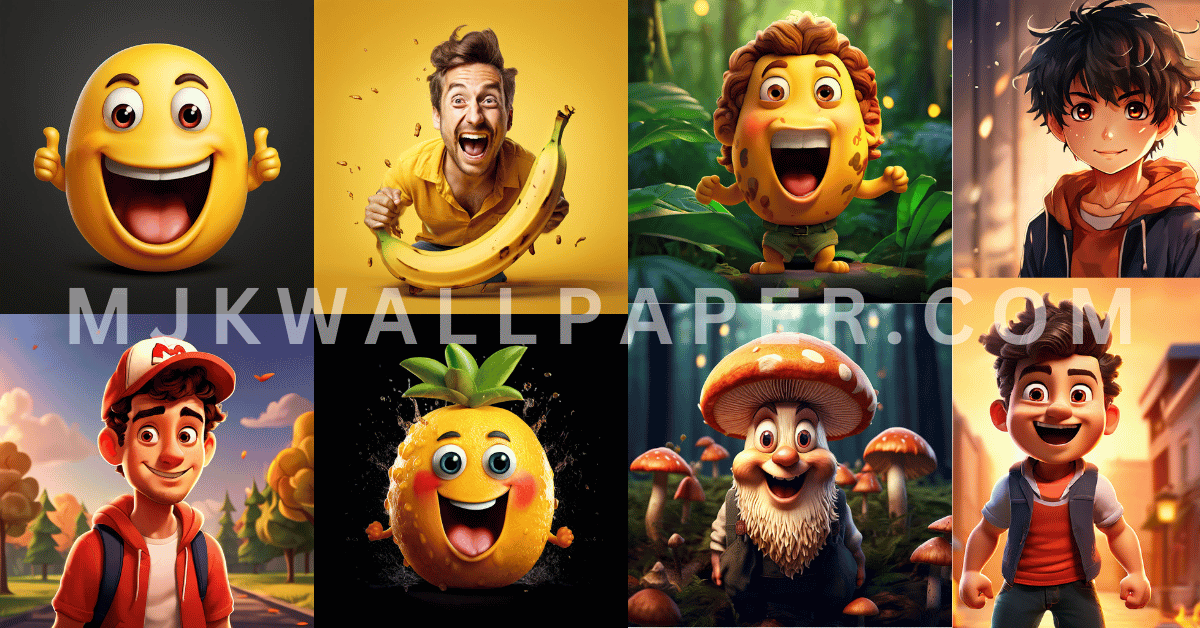I. Introduction to Funny PFPs
In the realm of online communication, one’s profile picture, commonly referred to as a PFP, serves as the digital face of one’s identity. However, while many opt for conventional or professional images, a rising trend has emerged – the use of funny PFPs.






These amusing and lighthearted images inject humor into online interactions, adding a touch of personality and charm to digital profiles. Whether it’s a quirky cartoon avatar, a witty meme-based PFP, or a customized creation bursting with laughter, funny PFPs have become a staple in the online landscape, offering users a unique way to express themselves.






Funny PFPs play a pivotal role in shaping online identity and social interactions. They serve as instant conversation starters, sparking laughter and camaraderie among peers. Moreover, in a sea of mundane profile pictures, a well-executed funny PFP has the power to leave a lasting impression, making one’s online presence memorable and engaging.
From social media platforms to professional networking sites, individuals are embracing the humor and creativity that funny PFPs bring to their digital personas, turning ordinary profiles into vibrant expressions of individuality.




The phenomenon of funny PFPs extends beyond mere amusement; it taps into the psychology of humor and its profound impact on human connection. Studies have shown that humor fosters rapport and strengthens social bonds, making interactions more enjoyable and memorable.
By incorporating funny PFPs into their online presence, individuals not only showcase their sense of humor but also invite others to engage in playful exchanges, fostering a sense of community in the digital realm.
II. Understanding Funny Profile Pictures: A Closer Look
Funny profile pictures, commonly abbreviated as funny PFPs, encompass a wide range of images designed to evoke laughter and amusement. Unlike traditional profile pictures, which often aim for professionalism or aesthetic appeal, funny PFPs prioritize humor and creativity.
These images can take various forms, including cartoons, memes, or personalized designs, each serving as a reflection of the user’s personality and sense of humor. Whether it’s a clever visual pun or a witty caption accompanying the image, funny PFPs add a playful twist to online identities, capturing the attention and admiration of viewers.
The popularity of funny PFPs stems from their ability to transcend language and cultural barriers, resonating with audiences worldwide. In an era dominated by social media and digital communication, humor serves as a universal language, bridging gaps and forging connections across diverse communities.
Funny PFPs, with their light-hearted charm and relatable humor, serve as powerful tools for building rapport and fostering online relationships. Whether used for personal accounts or professional profiles, these images create an instant connection, eliciting smiles and laughter from viewers.
Despite their whimsical nature, funny PFPs are not merely frivolous decorations; they play a significant role in shaping online identity and perception. In a virtual landscape saturated with information and content, standing out from the crowd is essential for garnering attention and engagement. Funny PFPs offer users a distinctive way to differentiate themselves and leave a lasting impression on viewers.
By incorporating humor into their profile pictures, individuals showcase their creativity, wit, and approachability, inviting others to engage in playful interactions and meaningful connections.
III. The Impact of Funny Profile Pictures: Adding Humor to Digital Interactions
The adoption of funny PFPs has revolutionized the way individuals present themselves in the digital sphere. Gone are the days of stiff and formal profile pictures; instead, users are embracing the light-hearted charm of humorous images. Whether it’s a quirky cartoon avatar depicting their alter ego or a cleverly edited meme that captures their unique sense of humor, funny PFPs allow individuals to express themselves authentically while eliciting laughter and joy from their audience.
Beyond personal expression, funny PFPs have profound implications for online interactions and social dynamics. In a virtual landscape where attention spans are fleeting, capturing the interest of others is paramount. Funny PFPs serve as attention magnets, drawing viewers in with their whimsical charm and inviting them to explore further.
Moreover, these images foster a sense of camaraderie and belonging, as users bond over shared laughter and appreciation for clever humor. Whether used in casual conversations or professional networking, funny PFPs create memorable experiences and forge lasting connections in the digital realm.
Furthermore, the impact of funny PFPs extends beyond individual profiles to broader online communities and cultural trends. As these images proliferate across social media platforms and digital forums, they shape the collective consciousness, influencing popular culture and societal norms.
From viral memes to iconic cartoon characters, funny PFPs have become cultural touchstones, uniting diverse audiences in shared laughter and amusement. In an increasingly interconnected world, where digital communication reigns supreme, funny PFPs serve as cultural artifacts, reflecting the ever-evolving landscape of humor and human expression.
IV. Types of Funny PFPs: Exploring Diversity in Humor
Funny PFPs come in a plethora of styles and formats, catering to diverse tastes and preferences. One popular category is cartoon avatars, which offer users the opportunity to embody whimsical characters and showcase their playful side.
Whether it’s a beloved childhood cartoon character or a custom-made avatar designed to resemble the user, cartoon-based funny PFPs infuse profiles with charm and personality, inviting viewers to engage in light-hearted banter and nostalgia-filled conversations.
Another prevalent type of funny PFP is meme-based imagery, which capitalizes on internet culture and viral trends to create humorous and relatable content. Memes, with their witty captions and iconic visuals, serve as a rich source of comedic material, providing users with endless opportunities for creative expression.
From classic memes that have stood the test of time to fresh and topical references, meme-based funny PFPs tap into the collective humor of online communities, fostering a sense of camaraderie and shared experience among viewers.
Additionally, customized funny PFPs offer users the freedom to unleash their creativity and imagination, crafting unique and personalized images that reflect their individuality. Whether it’s a clever photo edit, a whimsical illustration, or a witty combination of visual elements, customized funny PFPs allow users to stand out from the crowd and showcase their creative prowess.
By infusing their profiles with original and eye-catching imagery, individuals leave a memorable impression on viewers, sparking curiosity and admiration for their wit and ingenuity.
V. Creating the Perfect Funny PFP: Tips and Strategies
Designing a funny PFP that truly resonates with viewers requires careful consideration and attention to detail. One essential aspect to consider is choosing the right image that encapsulates the desired humor and personality.
Whether opting for a cartoon avatar, a meme-inspired creation, or a customized design, selecting an image that evokes genuine laughter and amusement is crucial for making a lasting impression on viewers. Additionally, incorporating visual puns, wordplay, or clever edits can elevate the humor of the PFP, adding an extra layer of wit and charm to the image.
Another important consideration when creating a funny PFP is maintaining relevance and timelessness. While it’s tempting to jump on the latest trend or meme bandwagon, opting for timeless humor that transcends fleeting fads ensures the longevity and staying power of the PFP.
By choosing humor that resonates with a broad audience and stands the test of time, individuals can ensure that their funny PFP remains engaging and relevant for years to come, avoiding the risk of becoming outdated or stale.
Furthermore, when designing a funny PFP, it’s essential to strike the right balance between humor and professionalism, especially in professional or public-facing contexts. While humor can be a powerful tool for building rapport and making connections, it’s important to consider the appropriateness of the humor and its alignment with the intended audience and context.
By exercising discretion and sensitivity, individuals can create funny PFPs that are both entertaining and appropriate for the intended audience, effectively leveraging humor to enhance their online presence without compromising professionalism.
VI. Risks and Considerations: Navigating Potential Challenges
Despite their playful nature, funny PFPs are not without risks, and it’s essential for users to be aware of potential pitfalls. One significant risk is the potential for backlash or negative reactions from viewers.
Humor is subjective, and what one person finds amusing, another may find offensive or inappropriate. When choosing or creating a funny PFP, it’s crucial to consider the sensibilities of the intended audience and exercise discretion to avoid inadvertently causing offense or discomfort.
Another consideration is ensuring cultural sensitivity in funny PFPs, particularly in a globalized online environment. What may be humorous in one cultural context could be perceived differently in another, leading to misunderstandings or unintended consequences. By being mindful of cultural differences and avoiding stereotypes or insensitive portrayals, individuals can create funny PFPs that resonate positively with viewers from diverse backgrounds, fostering inclusivity and mutual respect in online interactions.
Furthermore, individuals must strike the right balance between humor and professionalism, particularly in contexts where maintaining a professional image is paramount. While funny PFPs can be a valuable tool for adding personality and charm to digital profiles, they should not overshadow or detract from the individual’s credibility or professionalism.
By ensuring that their funny PFPs align with the expectations and norms of their professional field or industry, individuals can maintain a polished and respectable online presence while still injecting humor into their profiles.
VII. Showcasing Funny PFPs Across Platforms: Best Practices
Implementing funny PFPs across various online platforms requires careful consideration of each platform’s audience and conventions. On social media platforms such as Facebook, Twitter, and Instagram, where humor and personality are celebrated, funny PFPs can serve as powerful attention-grabbers, attracting followers and engagement.
However, it’s essential to tailor the humor and tone of the PFP to align with the platform’s culture and user demographics, ensuring that it resonates with the intended audience.
In professional settings such as LinkedIn or corporate websites, where maintaining a polished and professional image is paramount, individuals should approach funny PFPs with caution.
While a touch of humor can humanize one’s professional profile and make it more approachable, it’s crucial to strike the right balance between professionalism and lightheartedness. Opting for subtle humor or incorporating funny elements that align with the individual’s industry or expertise can enhance the profile without compromising its credibility or professionalism.
Additionally, individuals can explore alternative platforms and online communities where humor and creativity are celebrated, such as gaming forums, hobbyist groups, or niche interest communities. These platforms offer a fertile ground for showcasing funny PFPs and connecting with like-minded individuals who share a similar sense of humor and interests.
By strategically leveraging funny PFPs across diverse online platforms, individuals can expand their digital presence, forge meaningful connections, and showcase their unique personality and creativity to a wider audience.
VIII. The Evolution of Funny PFP Trends: A Historical Perspective
The landscape of funny PFPs is constantly evolving, reflecting changes in technology, culture, and online communication trends. Over the years, we’ve witnessed a dramatic shift in the types of humor and imagery used in PFPs, from simple caricatures to elaborate meme-based creations.
Early internet forums and chat platforms often featured basic cartoon avatars or pixel art representations as users’ profile pictures, reflecting the limited technology and design options available at the time.
However, as technology advanced and social media platforms emerged, the possibilities for funny PFPs expanded exponentially. Memes, which originated as simple images with humorous captions, quickly became a dominant form of online humor, spawning a new era of meme-inspired funny PFPs.
Users began incorporating popular memes and viral references into their profile pictures, creating a shared language of humor that transcended geographical and cultural boundaries.
Today, we continue to see the evolution of funny PFP trends, with users pushing the boundaries of creativity and humor in their profile pictures. From elaborate photo edits and digital illustrations to interactive GIFs and videos, funny PFPs have become increasingly sophisticated and dynamic, reflecting the ever-changing landscape of online communication.
As new technologies such as augmented reality and virtual reality continue to emerge, the future of funny PFPs holds limitless possibilities, promising even more immersive and engaging experiences for users.
IX. Incorporating Funny PFPs in Online Communities: Building Connections
Funny PFPs play a vital role in fostering a sense of community and camaraderie within online communities and social networks. In niche interest groups or fandom communities, funny PFPs serve as symbols of belonging, signaling shared interests and values among members.
Whether it’s a group of gaming enthusiasts sporting funny PFPs inspired by their favorite characters or a fan club celebrating a beloved celebrity with humorous profile pictures, funny PFPs create a sense of unity and solidarity among community members.
Moreover, in online forums and discussion groups, funny PFPs serve as conversation starters and icebreakers, sparking playful interactions and lively debates among participants. By injecting humor into their profile pictures, users invite others to engage in light-hearted banter and exchange witty remarks, fostering a sense of camaraderie and rapport.
Funny PFPs break down barriers and facilitate connections between individuals from diverse backgrounds, creating a welcoming and inclusive environment for online discourse and collaboration.
Additionally, funny PFPs contribute to the overall culture and atmosphere of online communities, shaping the collective identity and personality of the group. Whether it’s a community known for its irreverent humor and whimsical profile pictures or a group that prides itself on its wit and cleverness, funny PFPs play a central role in defining the community’s ethos and values.
By embracing humor and creativity in their profile pictures, community members contribute to a vibrant and dynamic online culture, where laughter and camaraderie reign supreme.
X. Impact on Mental Health and Well-being: The Therapeutic Role of Humor
The use of funny PFPs extends beyond mere amusement; it can also have a profound impact on mental health and well-being. Humor has long been recognized as a powerful coping mechanism, helping individuals navigate life’s challenges with resilience and perspective. By incorporating humor into their online presence through funny PFPs, individuals can lighten their mood, alleviate stress, and foster a sense of optimism and resilience in the face of adversity.
Studies have shown that laughter triggers the release of endorphins, the body’s natural feel-good chemicals, which can promote relaxation and reduce stress levels. By regularly encountering funny PFPs in their online interactions, individuals can experience a boost in mood and an increase in overall well-being.
Moreover, the act of sharing laughter with others through funny PFPs fosters a sense of connection and belonging, strengthening social bonds and reducing feelings of loneliness and isolation.
Additionally, humor has been shown to have positive effects on cognitive function, memory, and creativity. By engaging with funny PFPs and experiencing moments of laughter and amusement, individuals can enhance their cognitive abilities and mental agility.
Furthermore, the act of creating or customizing funny PFPs can serve as a form of self-expression and creative outlet, allowing individuals to explore their imagination and showcase their personality in a fun and lighthearted manner.
XI. Legal and Ethical Considerations: Navigating Copyright and Consent
While funny PFPs are a popular form of self-expression and communication, it’s essential for users to be mindful of legal and ethical considerations when selecting or creating their profile pictures. One important consideration is copyright law, which governs the use of images, artwork, and other creative works.
When choosing a funny PFP, individuals should ensure that they have the necessary rights or permissions to use the image, especially if it’s sourced from the internet or created by another artist.
Additionally, individuals should be mindful of the importance of obtaining consent and permission when using images of other people as their funny PFPs. While it may be tempting to use a humorous photo of a friend or celebrity as a profile picture, doing so without their consent could potentially infringe on their privacy rights or publicity rights.
By obtaining permission from the individuals depicted in the image, individuals can avoid legal complications and ethical dilemmas while still enjoying the humor and creativity of their chosen PFP.
Furthermore, individuals should adhere to ethical guidelines when creating or sharing funny PFPs, particularly in relation to sensitive or controversial topics. While humor can be a powerful tool for communication and expression, it’s essential to exercise discretion and avoid using humor that is offensive, discriminatory, or harmful to others.
By upholding ethical standards and respecting the rights and feelings of others, individuals can create a positive and inclusive online environment where humor can thrive without causing harm or offense.
XII. Case Studies and Examples: Illustrating the Power of Funny PFPs
Examining real-life examples of successful funny PFPs can provide valuable insights into the impact and effectiveness of humor in online identity. One notable case study is the use of funny PFPs by social media influencers and content creators to engage their audience and build a loyal following.
By incorporating humorous and relatable profile pictures into their online presence, these individuals create a sense of authenticity and approachability, attracting followers who resonate with their sense of humor and personality.
Another compelling example is the use of funny PFPs in marketing and branding campaigns to capture attention and drive engagement. Companies and brands often leverage humor in their profile pictures to humanize their brand image and connect with consumers on a personal level.
Whether it’s a witty cartoon avatar representing the brand’s mascot or a cleverly edited image that pokes fun at industry trends, funny PFPs can help companies stand out in a crowded marketplace and create memorable brand experiences for their audience.
Furthermore, examining cross-cultural examples of humorous PFPs can highlight the universal appeal of humor in online communication. While humor may vary across cultures and regions, certain types of humor, such as visual puns or slapstick comedy, have a broad appeal that transcends linguistic and cultural barriers.
By embracing humor in their profile pictures, individuals and communities from diverse backgrounds can connect with others and forge meaningful relationships based on shared laughter and amusement.
XIII. Tips for Designing Funny PFPs: Maximizing Impact
Designing a funny PFP that captures attention and resonates with viewers requires careful consideration and creativity. One essential tip is to choose an image that conveys the desired humor and personality effectively. Whether opting for a whimsical cartoon avatar, a cleverly edited meme, or a personalized illustration, selecting an image that elicits genuine laughter and amusement is key to making a memorable impression on viewers.
Additionally, incorporating visual elements such as puns, wordplay, or clever edits can enhance the humor of the PFP and make it more engaging and shareable. By adding witty captions, playful visual effects, or subtle references to popular culture, individuals can infuse their profile pictures with personality and charm, inviting viewers to engage in playful interactions and conversations.
Furthermore, it’s important to consider the context and audience when designing a funny PFP. While humor is subjective, being mindful of the preferences and sensibilities of the intended audience can help ensure that the PFP resonates positively with viewers. Whether it’s adapting the humor to suit the tone of a specific online community or avoiding sensitive topics or stereotypes, tailoring the funny PFP to the audience can increase its impact and effectiveness in capturing attention and fostering connections.
XIV. Personal Stories and Experiences: The Impact of Funny PFPs
Hearing personal anecdotes and experiences from individuals who have embraced funny PFPs can offer valuable insights into the power of humor in online identity. Many users have shared stories of how their funny PFPs have sparked conversations, forged friendships, and brought joy to their online interactions.
Whether it’s receiving compliments on their clever profile picture or sharing a laugh with strangers over a shared meme reference, funny PFPs have a way of brightening up the digital landscape and creating memorable moments for users.
Additionally, individuals have shared how funny PFPs have helped them navigate challenging times and cope with stress and anxiety. In moments of sadness or uncertainty, a humorous profile picture can serve as a source of comfort and levity, reminding users to find joy and laughter amidst life’s trials.
By embracing humor in their online presence, individuals can cultivate resilience and optimism, turning their digital profiles into beacons of positivity and laughter for themselves and others.
Furthermore, funny PFPs have played a significant role in shaping personal and professional relationships, bridging gaps and fostering connections across diverse communities. Many users have shared stories of how their funny PFPs have sparked conversations with strangers, led to collaborations and partnerships, and even opened doors to new opportunities.
Whether it’s bonding over a shared love of a particular meme or using humor to break the ice in a professional setting, funny PFPs have a way of bringing people together and building meaningful relationships that extend beyond the digital realm.
XV. Future Trends and Innovations: The Next Frontier of Funny PFPs
As technology continues to evolve and online communication trends shift, the future of funny PFPs holds limitless possibilities for innovation and creativity. One emerging trend is the use of augmented reality (AR) and virtual reality (VR) technologies to create immersive and interactive profile pictures.
Imagine being able to interact with a user’s funny PFP in real-time, or seeing it come to life through AR filters and animations. These advancements promise to take funny PFPs to new heights, offering users unprecedented opportunities for self-expression and engagement.
Furthermore, the integration of artificial intelligence (AI) and machine learning algorithms into funny PFP creation tools holds the potential to revolutionize the way users design and customize their profile pictures.
AI-powered tools can analyze user preferences and behavior to generate personalized recommendations for funny PFPs, making it easier than ever for individuals to find the perfect image that captures their sense of humor and personality. Additionally, AI algorithms can assist users in creating custom funny PFPs by automatically generating witty captions, suggesting visual elements, or even predicting trends in humor and pop culture.
Moreover, as online communities continue to evolve and diversify, we can expect to see new trends and themes emerge in the world of funny PFPs. From niche interest groups to global fandoms, funny PFPs will continue to serve as symbols of identity and belonging, fostering connections and sparking conversations among users from all walks of life. Whether it’s celebrating obscure internet memes or embracing cutting-edge digital art styles, the future of funny PFPs is sure to be filled with laughter, creativity, and endless possibilities.
XVI. Conclusion: Embracing the Humor of Funny Profile Pictures
In conclusion, funny profile pictures (PFPs) have emerged as powerful tools for self-expression, connection, and creativity in the digital age. From cartoon avatars to meme-inspired images, funny PFPs add a touch of humor and personality to online identities, making profiles more engaging and memorable.
By embracing humor in their online presence, individuals can spark conversations, forge connections, and brighten up the digital landscape with laughter and joy.
As we’ve explored throughout this article, funny PFPs have a profound impact on mental health and well-being, fostering positivity, resilience, and camaraderie among users. Whether it’s sharing a laugh with friends or finding solace in moments of difficulty, funny PFPs serve as beacons of light and levity in an increasingly digital world.
By incorporating humor into their online interactions, individuals can create meaningful connections and cultivate a sense of community and belonging that transcends geographical and cultural boundaries.
Looking ahead, the future of funny PFPs is filled with exciting possibilities for innovation and creativity. With advancements in technology and the continued evolution of online communication trends, we can expect to see new trends and innovations that push the boundaries of humor and creativity in digital identity.
From augmented reality experiences to AI-generated profile pictures, the next frontier of funny PFPs promises to be a thrilling journey filled with laughter, connection, and endless possibilities.
XVII. Frequently Asked Questions (FAQs) about Funny Profile Pictures
What makes a profile picture truly funny?
A truly funny profile picture captures attention and elicits genuine laughter by incorporating clever visual elements, witty captions, or humorous references that resonate with the viewer’s sense of humor.
Are there any risks associated with using humorous profile pictures?
While humorous profile pictures can enhance online interactions, there are risks of causing offense or misunderstanding if the humor is not well-received by all viewers. It’s important to be mindful of cultural sensitivities and avoid controversial or offensive content.
How can I ensure my funny profile picture is culturally sensitive?
To ensure cultural sensitivity, consider the diverse backgrounds and perspectives of your audience and avoid stereotypes or humor that may be perceived as insensitive or offensive.
Can using a funny profile picture affect my professional image negatively?
While humor can humanize your professional image and make you more approachable, it’s important to strike the right balance between professionalism and lightheartedness. Avoid using overly silly or inappropriate images that may detract from your credibility.
Are there any legal issues I should be aware of when using funny profile pictures?
Yes, it’s important to respect copyright laws and obtain permission to use images that you did not create yourself. Additionally, be mindful of privacy and publicity rights when using images of other people as your profile picture.
Can funny profile pictures improve mental well-being?
Yes, studies have shown that humor has a positive impact on mental health, promoting relaxation, reducing stress, and fostering a sense of connection and well-being.
How often should I change my funny profile picture to keep it fresh?
The frequency of changing your profile picture depends on personal preference and the platform’s norms. Some users change their profile pictures frequently to keep their content fresh, while others prefer to maintain a consistent image.
What are some tips for designing a funny profile picture that stands out?
Choose an image that captures your personality and sense of humor effectively, incorporate visual elements or captions that add wit and charm, and consider the preferences and sensibilities of your audience.
Can I use famous memes or images for my funny profile picture legally?
It’s best to use original or licensed images to avoid copyright infringement. However, if you choose to use a famous meme or image, ensure that you have the necessary rights or permissions to do so.
Should I consider my audience’s preferences when choosing a funny profile picture?
Yes, considering your audience’s preferences and sensibilities is crucial for creating a profile picture that resonates positively with viewers. Be mindful of cultural differences and avoid humor that may be offensive or inappropriate for your audience.
